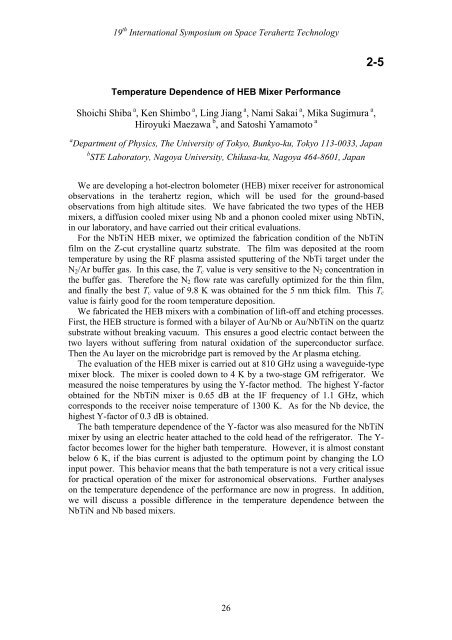Program and Abstract Book - SRON
Program and Abstract Book - SRON
Program and Abstract Book - SRON
You also want an ePaper? Increase the reach of your titles
YUMPU automatically turns print PDFs into web optimized ePapers that Google loves.
19 th International Symposium on Space Terahertz Technology<br />
2-5<br />
Temperature Dependence of HEB Mixer Performance<br />
Shoichi Shiba a , Ken Shimbo a , Ling Jiang a , Nami Sakai a , Mika Sugimura a ,<br />
Hiroyuki Maezawa b , <strong>and</strong> Satoshi Yamamoto a<br />
a Department of Physics, The University of Tokyo, Bunkyo-ku, Tokyo 113-0033, Japan<br />
b STE Laboratory, Nagoya University, Chikusa-ku, Nagoya 464-8601, Japan<br />
We are developing a hot-electron bolometer (HEB) mixer receiver for astronomical<br />
observations in the terahertz region, which will be used for the ground-based<br />
observations from high altitude sites. We have fabricated the two types of the HEB<br />
mixers, a diffusion cooled mixer using Nb <strong>and</strong> a phonon cooled mixer using NbTiN,<br />
in our laboratory, <strong>and</strong> have carried out their critical evaluations.<br />
For the NbTiN HEB mixer, we optimized the fabrication condition of the NbTiN<br />
film on the Z-cut crystalline quartz substrate. The film was deposited at the room<br />
temperature by using the RF plasma assisted sputtering of the NbTi target under the<br />
N 2 /Ar buffer gas. In this case, the T c value is very sensitive to the N 2 concentration in<br />
the buffer gas. Therefore the N 2 flow rate was carefully optimized for the thin film,<br />
<strong>and</strong> finally the best T c value of 9.8 K was obtained for the 5 nm thick film. This T c<br />
value is fairly good for the room temperature deposition.<br />
We fabricated the HEB mixers with a combination of lift-off <strong>and</strong> etching processes.<br />
First, the HEB structure is formed with a bilayer of Au/Nb or Au/NbTiN on the quartz<br />
substrate without breaking vacuum. This ensures a good electric contact between the<br />
two layers without suffering from natural oxidation of the superconductor surface.<br />
Then the Au layer on the microbridge part is removed by the Ar plasma etching.<br />
The evaluation of the HEB mixer is carried out at 810 GHz using a waveguide-type<br />
mixer block. The mixer is cooled down to 4 K by a two-stage GM refrigerator. We<br />
measured the noise temperatures by using the Y-factor method. The highest Y-factor<br />
obtained for the NbTiN mixer is 0.65 dB at the IF frequency of 1.1 GHz, which<br />
corresponds to the receiver noise temperature of 1300 K. As for the Nb device, the<br />
highest Y-factor of 0.3 dB is obtained.<br />
The bath temperature dependence of the Y-factor was also measured for the NbTiN<br />
mixer by using an electric heater attached to the cold head of the refrigerator. The Y-<br />
factor becomes lower for the higher bath temperature. However, it is almost constant<br />
below 6 K, if the bias current is adjusted to the optimum point by changing the LO<br />
input power. This behavior means that the bath temperature is not a very critical issue<br />
for practical operation of the mixer for astronomical observations. Further analyses<br />
on the temperature dependence of the performance are now in progress. In addition,<br />
we will discuss a possible difference in the temperature dependence between the<br />
NbTiN <strong>and</strong> Nb based mixers.<br />
26
















